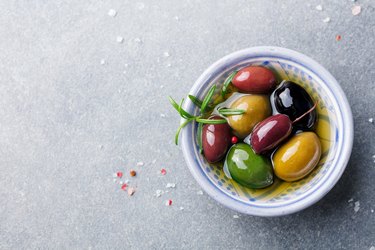
Fluid balance and blood volume are regulated in the human body by the electrolytes sodium and potassium. Many people are eating too many sodium-rich foods and not enough potassium-rich foods. So, are there any fruits and vegetables with lots of sodium you should avoid?
Balancing Sodium and Potassium
Video of the Day
The American Heart Association explains that when you have excess sodium in your bloodstream, this can lead to excess water in your blood vessels and increased blood volume. This, in turn, raises your blood pressure.
Video of the Day
High blood pressure is such a major problem because it can harm the walls of your blood vessels and contribute to the buildup of plaque, ultimately leading to heart disease. In addition to reducing excess sodium in your diet, you can offset its effects on your blood pressure by consuming more potassium.
The issue, as the Centers for Disease Control and Prevention (CDC) notes, is not necessarily added salt from the salt shaker — it's that people are consuming too many sodium-rich foods that are processed or packaged. As much as 70 percent of the sodium Americans eat comes from these foods, and only about 5 percent comes from adding table salt.
Sodium-rich foods include white bread and processed meat, according to the CDC. Sodium can be found, to a lesser extent, naturally in fruits and vegetables. However, you're not likely to hear about sodium-rich fruits or vegetables.
Foods High in Sodium and Potassium
So, why is it you're not likely to hear about sodium-rich fruits and vegetables? Because fruits and vegetables naturally don't have that much. The Produce for a Better Health Foundation classifies fruits and vegetables as low in sodium, very low in sodium and sodium free.
Low-sodium fruits and vegetables are those that have less than 140 milligrams but more than 35 milligrams. These include artichoke, bell peppers, broccoli, carrots, celery, radishes and sweet potatoes. This is probably the closest you'll come to finding sodium-rich fruits and vegetables, and even their amounts of sodium are low, as you can safely have up to 2,300 milligrams of sodium per day, per the CDC.
That's not to say that processed fruits and vegetables don't have a lot of sodium. Canned vegetables and soups are among the sodium-rich foods you might find in an American diet, according to the CDC. Some of these canned goods, however, might constitute foods high in sodium and potassium. For example, 1 cup of canned peas and carrots has 663 milligrams of sodium and 225 milligrams of potassium.
The CDC emphasizes getting more potassium-rich foods in your diet: potatoes, tomatoes, leafy greens, sweet potatoes, beans, bananas, dairy products, salmon and clams.
Adding table salt to these foods or including them in a high-salt recipe might result in foods that are high in sodium and potassium — and great for fluid balance. If you're a person who loses a lot of fluid through sweating, consuming these foods high in sodium and potassium could be good for you, according to the University of Michigan.
Sodium-rich foods are not necessarily bad for you, but they can have negative effects on your blood pressure if they're consumed in excess and out of balance with potassium. Cut back on the processed foods and fill up on fruits and vegetables, which will give you the small amounts of sodium you need with much of the potassium you might otherwise be lacking.
- Centers for Disease Control and Prevention: “Get the Facts: Sources of Sodium in Your Diet”
- Produce for a Better Health Foundation: “Sodium in Fruits and Vegetables”
- My Food Data: “Peas and Carrots”
- American Heart Association: “Get the Scoop on Sodium and Salt”
- Michigan Medicine: “Sodium (Na) in Blood”